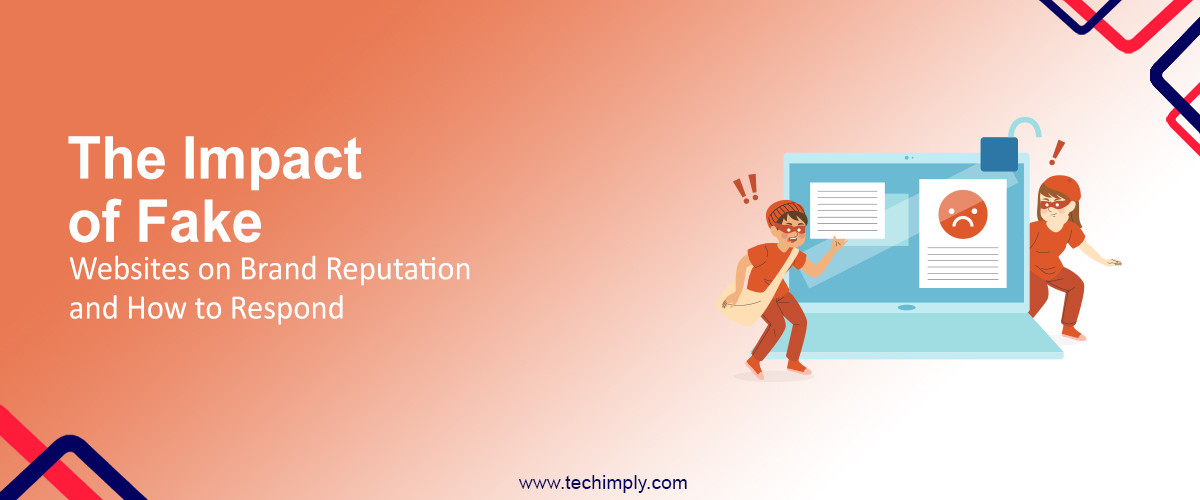There is a result for every action, just as there are various harmful impacts of fake websites on brands and businesses of honest people. The impact on brand reputation could cost the brand a lot, from losing customers to losing money due to legal battles, especially if the scam site was not detected early.
Responding to fake websites has to be strategic. It has to be swift and effective, and most of all, brand and business owners should have a system for continuous monitoring of their websites and trademarks.
The Impact Of Fake Websites On Brand Reputation
Deceptive online entities not only disseminate misinformation but also undermine the trust painstakingly built by brands. Here are some of the impacts of fake websites on brand reputation.
1. Spread of Misinformation
These false platforms imitate legitimate brands and unaware consumers are often subjected to false or misleading information. The misleading could be in any form, it could be the fabrication of data related to the original products, deceptive reviews to gain trust, or incorrect company details to lure in customers, and serious negative results can occur.
These days, users increasingly rely on internet sources for research and decision-making, and the prevalence of misinformation damages the trustworthiness of an affected brand, which leads to a distorted image that is not easily correctable.
2. Trust Erosion
Fake websites play a pivotal role in corrupting the trust that consumers place in a brand. In this time, putting your bank details online can cause a loss of balance. People are now more discerning and cautious in their online interactions, and encountering a deceptive website can instill doubt and mistrust.
Customers may question the legitimacy of official channels, doubting the authenticity of products, services, and communications from the original, authentic brand. This erosion of trust can result in diminished customer loyalty, reduced repeat business, and a tarnished brand image that may take considerable effort to rebuild or be lost permanently.
3. Financial Repercussions
The impact of fake websites extends beyond reputation damage; it also affects a brand's financial health and stand. Consumers who fall victim to deceptive websites may make purchases based on false representations, leading to dissatisfaction upon discovering the discrepancies between expectations and reality.
This dissatisfaction can result in increased returns, refunds, and negative online reviews, causing direct financial losses for the brand. Moreover, the legal consequences of trademark infringement or consumer protection issues can further strain the brand's financial resources.
In essence, the spread of misinformation, trust erosion, and financial repercussions form a trifecta of challenges that fake websites present to brand reputation. Weakening the potential harm caused by these fake online entities requires a comprehensive strategy that includes preventive steps, careful monitoring, and thoughtful or strategic responses.
Common Characteristics Of Fake Websites
1. Poor Design and User Interface
Fake websites often exhibit subpar design and user interface elements. This may include low-resolution images, inconsistent fonts, and an overall unprofessional aesthetic. These flaws are a sign of a hurriedly put together website that seeks to fool users instead of offering a real and reliable experience.
2. Suspicious URLs and Domain Names
The URL and domain name of a website can offer valuable hints about its legitimacy. Fake websites often use misspelled versions of popular domains, extra hyphens, or unconventional extensions. Examining the URL closely can reveal inconsistencies that help identify whether the site is an authentic representation of the brand it claims to be.
3. Lack of Contact Information
Authentic websites prioritize transparent communication with their audience. Fake websites, on the other hand, often lack essential contact information such as a physical address, customer support email, or phone number. The absence of these details raises suspicions about the legitimacy or the originality of the website and the brand it appears to represent.
Tools and Techniques For Verification Of Fake Websites
1. Online Verification Tools
Various online tools are designed to assess the legitimacy of a website. These tools analyze factors such as domain age, registration details, and historical data to determine the likelihood of a website being fake. Leveraging these tools can provide a quick and automated way to assess the authenticity of a website.
2. Cross-referencing with Official Channels
Cross-referencing information with official channels is a crucial step in verifying the legitimacy of a website. Comparing details such as contact information, product descriptions, and pricing with the official sources, such as the brand's official website or social media accounts, can help confirm the authenticity of the online presence.
3. User Education on Recognizing Fake Websites
A preventive strategy for combating online deception is to empower users with the information they need to identify fake websites. Informing users about common characteristics of fake websites and teaching them to conduct basic verification checks on any online platform through educational resources, guidelines, and awareness campaigns.
Recognizing online scams demands an amalgamation of watchfulness, tech tools and people skills. By learning the typical characteristics of fraudulent websites and applying validating processes, individuals and organizations can act preventatively to avoid becoming victims of internet scams.
Responding To Fake Websites
To respond to the activities of a fake website, brands can do this in three ways or stages, through proactive measures, reactive strategies (this is for when the fake site has been discovered), and through legal actions.
1.Proactive Measures
- Regular Monitoring of Online Presence
Frequent and thorough monitoring of the brand's online presence is a foundational proactive measure. A tool notable or worthy to mention is brand monitoring software, through which brands can stay vigilant against the emergence of fake websites attempting to mimic their identity.
- Establishing Official Communication Channels
Creating and clearly communicating official communication channels is crucial for both the brand and its customers. With established verified social media profiles (with the blue tick), official websites, and designated customer support channels, brands can offer users reliable points of contact. This will enhance trust and also provide a reference for customers to verify the legitimacy of information online.
2.Reactive Strategies
- Issuing Official Statements
In the event of a fake website posing a threat to the brand's reputation, issuing official statements is an effective reactive strategy. Communicating directly with the audience through press releases, social media posts, and official blog updates allows the brand to address concerns, correct misinformation, and assert its true identity.
- Collaborating with Online Platforms to Remove Fake Content
Coordinating with online platforms and reporting the presence of fake websites is a collaborative approach to combating online deception. When brands work closely with platforms hosting fraudulent content, brands can learn how to report a website and speed up the removal of fake websites, thereby minimizing the potential harm caused to their reputation and customers.
3.Legal Actions
- Trademark Infringement Cases
Taking legal action against fake websites through trademark infringement cases is a robust way to protect the brand's intellectual property. This involves pursuing legal remedies against entities that unlawfully use the brand's trademarks, logos, or copyrighted material to deceive consumers.
- Reporting to Relevant Authorities
Reporting scam websites to relevant authorities is a civic responsibility that helps protect not only the affected brand but also the broader online community. Utilizing platforms and agencies designated for reporting cybercrime and fraudulent activities ensures that legal measures can be taken against the perpetrators.
Conclusion
Fake websites are a true menace and dealing with them should be strategic, as a brand's reputation is its face. Protect your website by having a continuous system of monitoring for your peace of mind and that of your customers.


.png)



